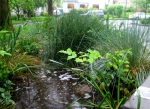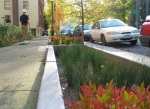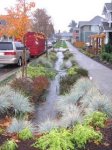What are Green Streets?
Green Streets are neighborhood streets with stormwater management features, often utilizing natural elements, which can remove and filter storm water runoff before it reaches the storm drain.
You may want to check out the Portland Bureau of Environmental Services “What is a Green Street?” flyer for a succinct overview.

Why are Green Streets Important?
Portland’s early sewers collected sewage from homes and businesses and stormwater runoff from streets in the same pipes. The mixture of sewage and stormwater in this combined sewer system drained directly to the Willamette River and the Columbia Slough without treatment.
In the early 1950s, the city installed large pipes next to the river and slough to intercept sewage and carry it to Portland’s first sewage treatment plant, the Columbia Boulevard Wastewater Treatment Plant. When it’s not raining, all the sewage goes to the plant for treatment. But during wet weather, stormwater fills the combined sewer pipes to capacity and untreated sewage can overflow into the Willamette River and Columbia Slough. Combined sewer overflows (CSOs) generally occur in Portland only during extremely heavy rains and the city is enlarging pipes to reduce the problem. However, replacing underground pipes under streets is expensive – and disruptive to traffic flow. Installing Green Streets helps to reduce the amount of stormwater entering existing pipes. This saves taxpayer money by reducing the need to replace pipes and the need for long-term street closures – while also helping the environment by preventing street pollution from entering the stormwater system.
Keeping stormwater runoff out of sewer pipes not only helps eliminate combined sewer overflows into our rivers, it also reduces street flooding and sewer backups in basements.















